Optimization of Printing Parameters Based on Computational Fluid Dynamics (CFD) for Uniform Filament Mass Distribution at Corners in 3D Cementitious Material Printing
Abstract
1. Introduction
2. Theory
2.1. Numerical Model
2.2. SVM and Transfer Learning
| Algorithm 1. Algorithm of TrAdaBoost for transfer learning. |
| Input labelled source domain samples As and labelled target domain samples as training data. Determine a classical SVM learner and maximum iterations N. Initialise the weight vector of the training data as For t =1, 2, 3…, N. . : X→Y is determined. in target domain At Then, Update the weight vector based on the training data: t = t + 1 |
| Output decision function: |
3. Numerical Model Validation
4. Results and Discussion
4.1. Identify Printing Process Windows at Tool Path Radii R of 30 mm and 35 mm
4.2. Identify Printing Process Windows of Nozzle Aspect Ratio φ at 1.5 and 2.0
4.3. Identify Printing Process Windows at the Relative Nozzle Travel Speeds ζ of 1.10 and 1.05
5. Determination of Three-Dimensional Optimized Printing Process Window
6. Effectiveness Validation of the Machine Learning
7. Conclusions
- Two-dimensional printing process windows were identified using the support vector machine method with a threshold Φ = 1.20 for specific printing process parameters in the designed domains. The optimized two-dimensional printing process windows show the complex correlation between printing process parameters and filament cross-section ratio Φ at corners.
- The printing process parameters affect the material flow behaviour considerably, and hence the filament cross-section ratio at its corners. The contours of the cementitious material ratio and radial velocity of the material obtained from CFD results show that the material flows in three-dimensional domains during extrusion and deposition processes.
- Transfer learning was used to identify the printing process windows efficiently. Compared to the SVM model, the transfer learning predicts the filament cross-section ratio with better accuracy for most printing process parameters.
- A three-dimensional printing process window was identified to explore the correlation between all printing process parameters and cross-section ratio Φ. The experimental results show the reliability of the printing process window identification in 3DCMP at corners.
Author Contributions
Funding
Data Availability Statement
Acknowledgments
Conflicts of Interest
References
- Liu, Z.; Li, M.; Weng, Y.; Wong, T.N.; Tan, M.J. Mixture Design Approach to optimize the rheological properties of the material used in 3D cementitious material printing. Constr. Build. Mater. 2019, 198, 245–255. [Google Scholar] [CrossRef]
- Panda, B.; Unluer, C.; Tan, M.J. Extrusion and rheology characterization of geopolymer nanocomposites used in 3D printing. Compos. Part B Eng. 2019, 176, 107290. [Google Scholar] [CrossRef]
- Zhu, B.; Nematollahi, B.; Pan, J.; Zhang, Y.; Zhou, Z.; Zhang, Y. 3D concrete printing of permanent formwork for concrete column construction. Cem. Concr. Compos. 2021, 121, 104039. [Google Scholar] [CrossRef]
- Mechtcherine, V.; Buswell, R.; Kloft, H.; Bos, F.P.; Hack, N.; Wolfs, R.; Saranjan, J.; Nematollahi, B.; Ivaniuk, E.; Neef, T. Integrating reinforcement in digital fabrication with concrete: A review and classification framework. Cem. Concr. Compos. 2021, 119, 103964. [Google Scholar] [CrossRef]
- Xiao, J.; Ji, G.; Zhang, Y.; Ma, G.; Mechtcherine, V.; Pan, J.; Wang, L.; Ding, T.; Duan, Z.; Du, S. Large-scale 3D printing concrete technology: Current status and future opportunities. Cem. Concr. Compos. 2021, 122, 104115. [Google Scholar] [CrossRef]
- Ma, G.; Li, Z.; Wang, L.; Wang, F.; Sanjayan, J. Mechanical anisotropy of aligned fiber reinforced composite for extrusion-based 3D printing. Constr. Build. Mater. 2019, 202, 770–783. [Google Scholar] [CrossRef]
- Le, T.T.; Austin, S.A.; Lim, S.; Buswell, R.A.; Gibb, A.G.; Thorpe, T. Mix design and fresh properties for high-performance printing concrete. Mater. Struct. 2012, 45, 1221–1232. [Google Scholar] [CrossRef]
- Ma, G.; Li, Z.; Wang, L. Printable properties of cementitious material containing copper tailings for extrusion based 3D printing. Constr. Build. Mater. 2018, 162, 613–627. [Google Scholar] [CrossRef]
- Liu, C.; Wang, X.; Chen, Y.; Zhang, C.; Ma, L.; Deng, Z.; Chen, C.; Zhang, Y.; Pan, J.; Banthia, N. Influence of hydroxypropyl methylcellulose and silica fume on stability, rheological properties, and printability of 3D printing foam concrete. Cem. Concr. Compos. 2021, 122, 104158. [Google Scholar] [CrossRef]
- Weng, Y.; Li, M.; Liu, Z.; Lao, W.; Lu, B.; Zhang, D.; Tan, M.J. Printability and fire performance of a developed 3D printable fibre reinforced cementitious composites under elevated temperatures. Virtual Phys. Prototyp. 2019, 14, 284–292. [Google Scholar] [CrossRef]
- Hambach, M.; Rutzen, M.; Volkmer, D. Properties of 3D-printed fiber-reinforced Portland cement paste. In 3D Concrete Printing Technology; Elsevier: Amsterdam, The Netherlands, 2019; pp. 73–113. [Google Scholar]
- Nguyen, K.T.; Navaratnam, S.; Mendis, P.; Zhang, K.; Barnett, J.; Wang, H. Fire safety of composites in prefabricated buildings: From fibre reinforced polymer to textile reinforced concrete. Compos. Part B Eng. 2020, 187, 107815. [Google Scholar] [CrossRef]
- Panda, B.; Ruan, S.; Unluer, C.; Tan, M.J. Improving the 3D printability of high volume fly ash mixtures via the use of nano attapulgite clay. Compos. Part B Eng. 2019, 165, 75–83. [Google Scholar] [CrossRef]
- Tay, Y.; Panda, B.; Ting, G.; Ahamed, N.; Tan, M.; Chua, C. 3D printing for sustainable construction. In Industry 4.0–Shaping The Future of The Digital World, Proceedings of the 2nd International Conference on Sustainable Smart Manufacturing (S2M 2019), Manchester, UK, 9–11 April 2019; CRC Press: Boca Raton, FL, USA, 2020; p. 119. [Google Scholar]
- Ting, A.G.H.; Tay, D.Y.W.; Annapareddy, A.; Li, M.; Tan, M.J. Effect of Recycled Glass Gradation in 3D Cementitious Material Printing; Nanyang Technological University: Singapore, 2018. [Google Scholar]
- Li, Z.; Wang, L.; Ma, G. Mechanical improvement of continuous steel microcable reinforced geopolymer composites for 3D printing subjected to different loading conditions. Compos. Part B Eng. 2020, 187, 107796. [Google Scholar] [CrossRef]
- Xia, M.; Sanjayan, J. Method of formulating geopolymer for 3D printing for construction applications. Mater. Des. 2016, 110, 382–390. [Google Scholar] [CrossRef]
- Muthukrishnan, S.; Ramakrishnan, S.; Sanjayan, J. Effect of alkali reactions on the rheology of one-part 3D printable geopolymer concrete. Cem. Concr. Compos. 2021, 116, 103899. [Google Scholar] [CrossRef]
- Bos, F.; Wolfs, R.; Ahmed, Z.; Salet, T. Additive manufacturing of concrete in construction: Potentials and challenges of 3D concrete printing. Virtual Phys. Prototyp. 2016, 11, 209–225. [Google Scholar] [CrossRef]
- Tay, Y.W.D.; Li, M.Y.; Tan, M.J. Effect of printing parameters in 3D concrete printing: Printing region and support structures. J. Mater. Process. Technol. 2019, 271, 261–270. [Google Scholar] [CrossRef]
- Tay, Y.W.D.; Qian, Y.; Tan, M.J. Printability region for 3D concrete printing using slump and slump flow test. Compos. Part B Eng. 2019, 174, 106968. [Google Scholar] [CrossRef]
- Serdeczny, M.P.; Comminal, R.; Pedersen, D.B.; Spangenberg, J. Experimental validation of a numerical model for the strand shape in material extrusion additive manufacturing. Addit. Manuf. 2018, 24, 145–153. [Google Scholar] [CrossRef]
- Sanjayan, J.G.; Nematollahi, B.; Xia, M.; Marchment, T. Effect of surface moisture on inter-layer strength of 3D printed concrete. Constr. Build. Mater. 2018, 172, 468–475. [Google Scholar] [CrossRef]
- Kwon, H. Experimentation and Analysis of Contour Crafting (CC) Process Using Uncured Ceramic Materials. Ph.D Thesis, University of Southern California, Los Angeles, CA, USA, 2002. [Google Scholar]
- Comminal, R.; Serdeczny, M.P.; Pedersen, D.B.; Spangenberg, J. Numerical modeling of the strand deposition flow in extrusion-based additive manufacturing. Addit. Manuf. 2018, 20, 68–76. [Google Scholar] [CrossRef]
- Comminal, R.; Serdeczny, M.; Pedersen, D.; Spangenberg, J. Numerical Modeling of the Material Deposition and Contouring Precision in Fused Deposition Modeling. In Proceedings of the 29th Annual International Solid Freeform Fabrication Symposium (SFF Symp 2018), Austin, TX, USA, 13–15 August 2018; pp. 1855–1864. [Google Scholar]
- Liu, Z.; Li, M.; Weng, Y.; Qian, Y.; Wong, T.N.; Tan, M.J. Modelling and parameter optimization for filament deformation in 3D cementitious material printing using support vector machine. Compos. Part B Eng. 2020, 193, 108018. [Google Scholar] [CrossRef]
- Lao, W.; Li, M.; Tjahjowidodo, T. Variable-Geometry Nozzle for Surface Quality Enhancement in 3D Concrete Printing. Addit. Manuf. 2020, 37, 101638. [Google Scholar] [CrossRef]
- Carneau, P.; Mesnil, R.; Roussel, N.; Baverel, O. Additive manufacturing of cantilever-from masonry to concrete 3D printing. Autom. Constr. 2020, 116, 103184. [Google Scholar] [CrossRef]
- Duty, C.; Ajinjeru, C.; Kishore, V.; Compton, B.; Hmeidat, N.; Chen, X.; Liu, P.; Hassen, A.A.; Lindahl, J.; Kunc, V. What makes a material printable? A viscoelastic model for extrusion-based 3D printing of polymers. J. Manuf. Process. 2018, 35, 526–537. [Google Scholar] [CrossRef]
- Jin, Y.-A.; He, Y.; Fu, J.-Z.; Gan, W.-F.; Lin, Z.-W. Optimization of tool-path generation for material extrusion-based additive manufacturing technology. Addit. Manuf. 2014, 1, 32–47. [Google Scholar] [CrossRef]
- Jin, Y.-A.; Li, H.; He, Y.; Fu, J.-Z. Quantitative analysis of surface profile in fused deposition modelling. Addit. Manuf. 2015, 8, 142–148. [Google Scholar] [CrossRef]
- Ertay, D.S.; Yuen, A.; Altintas, Y. Synchronized material deposition rate control with path velocity on fused filament fabrication machines. Addit. Manuf. 2018, 19, 205–213. [Google Scholar] [CrossRef]
- Comminal, R.; Serdeczny, M.P.; Pedersen, D.B.; Spangenberg, J. Motion planning and numerical simulation of material deposition at corners in extrusion additive manufacturing. Addit. Manuf. 2019, 29, 100753. [Google Scholar] [CrossRef]
- Liu, Z.; Li, M.; Tay, Y.W.D.; Weng, Y.; Wong, T.N.; Tan, M. Rotation nozzle and numerical simulation of mass distribution at corners in 3D cementitious material printing. Addit. Manuf. 2020, 34, 101190. [Google Scholar] [CrossRef]
- Zhang, H.; Moon, S.K.; Ngo, T.H. Hybrid machine learning method to determine the optimal operating process window in aerosol jet 3D printing. ACS Appl. Mater. Interfaces 2019, 11, 17994–18003. [Google Scholar] [CrossRef]
- Aoyagi, K.; Wang, H.; Sudo, H.; Chiba, A. Simple method to construct process maps for additive manufacturing using a support vector machine. Addit. Manuf. 2019, 27, 353–362. [Google Scholar] [CrossRef]
- Zhang, H.; Moon, S.K. Reviews on Machine Learning Approaches for Process Optimization in Noncontact Direct Ink Writing. ACS Appl. Mater. Interfaces 2021, 13, 53323–53345. [Google Scholar] [CrossRef]
- Wang, G.; Huang, P.; Zhang, Y. Numerical analysis of metal transfer in gas metal arc welding. Metall. Mater. Trans. B 2003, 34, 345–353. [Google Scholar] [CrossRef]
- Hosseinpoor, M.; Yahia, A.; Khayat, K.H. Modeling of flow performance of self-consolidating concrete using Dam Break Theory and computational fluid dynamics. Cem. Concr. Compos. 2019, 102, 14–27. [Google Scholar] [CrossRef]
- He, L.; Chow, W.T.; Li, H. Effects of interlayer notch and shear stress on interlayer strength of 3D printed cement paste. Addit. Manuf. 2020, 36, 101390. [Google Scholar] [CrossRef]
- Fuster, D.; Bagué, A.; Boeck, T.; Le Moyne, L.; Leboissetier, A.; Popinet, S.; Ray, P.; Scardovelli, R.; Zaleski, S. Simulation of primary atomization with an octree adaptive mesh refinement and VOF method. Int. J. Multiph. Flow 2009, 35, 550–565. [Google Scholar] [CrossRef]
- Wang, G.; Huang, P.; Zhang, Y. Numerical analysis of metal transfer in gas metal arc welding under modified pulsed current conditions. Metall. Mater. Trans. B 2004, 35, 857–866. [Google Scholar] [CrossRef]
- He, L.; Tan, J.Z.M.; Chow, W.T.; Li, H.; Pan, J. Design of novel nozzles for higher interlayer strength of 3D printed cement paste. Addit. Manuf. 2021, 48, 102452. [Google Scholar] [CrossRef]
- Wu, D.; Hu, M.; Huang, Y.; Zhang, P.; Yu, Z. In situ monitoring and penetration prediction of plasma arc welding based on welder intelligence-enhanced deep random forest fusion. J. Manuf. Process. 2021, 66, 153–165. [Google Scholar] [CrossRef]
- Weiss, K.; Khoshgoftaar, T.M.; Wang, D. A survey of transfer learning. J. Big Data 2016, 3, 9. [Google Scholar] [CrossRef]
- Pan, S.J.; Yang, Q. A survey on transfer learning. IEEE Trans. Knowl. Data Eng. 2009, 22, 1345–1359. [Google Scholar] [CrossRef]
- Zhang, H.; Choi, J.P.; Moon, S.K.; Ngo, T.H. A knowledge transfer framework to support rapid process modeling in aerosol jet printing. Adv. Eng. Inform. 2021, 48, 101264. [Google Scholar] [CrossRef]
- Han, W.; Jafari, M.A.; Danforth, S.C.; Safari, A. Tool path-based deposition planning in fused deposition processes. J. Manuf. Sci. Eng. 2002, 124, 462–472. [Google Scholar] [CrossRef]
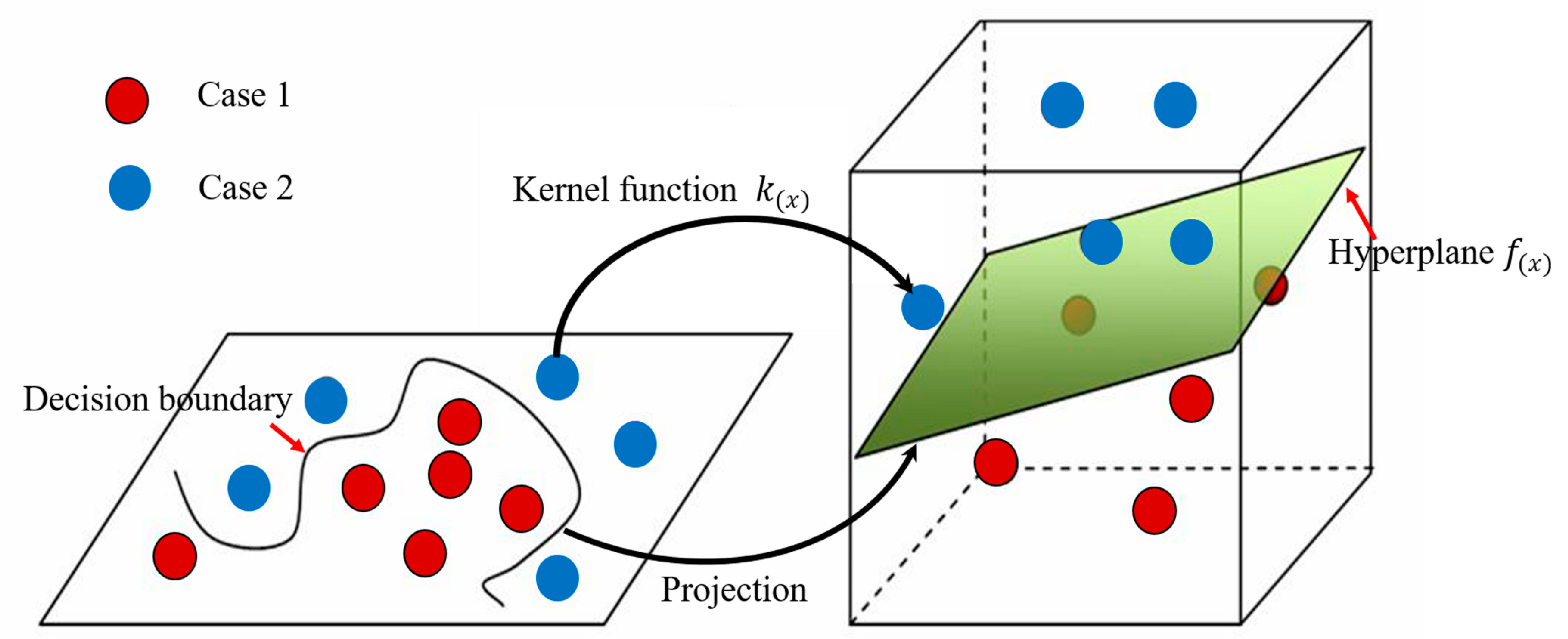
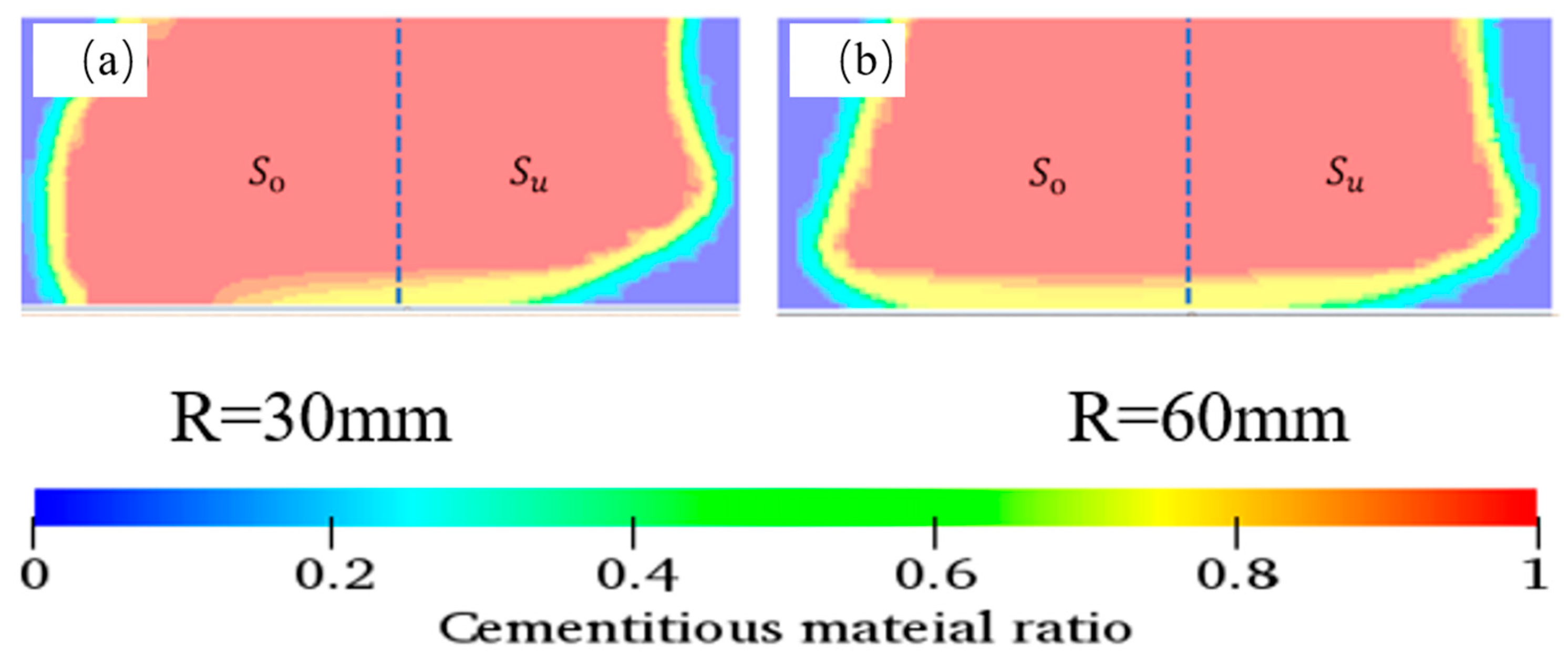
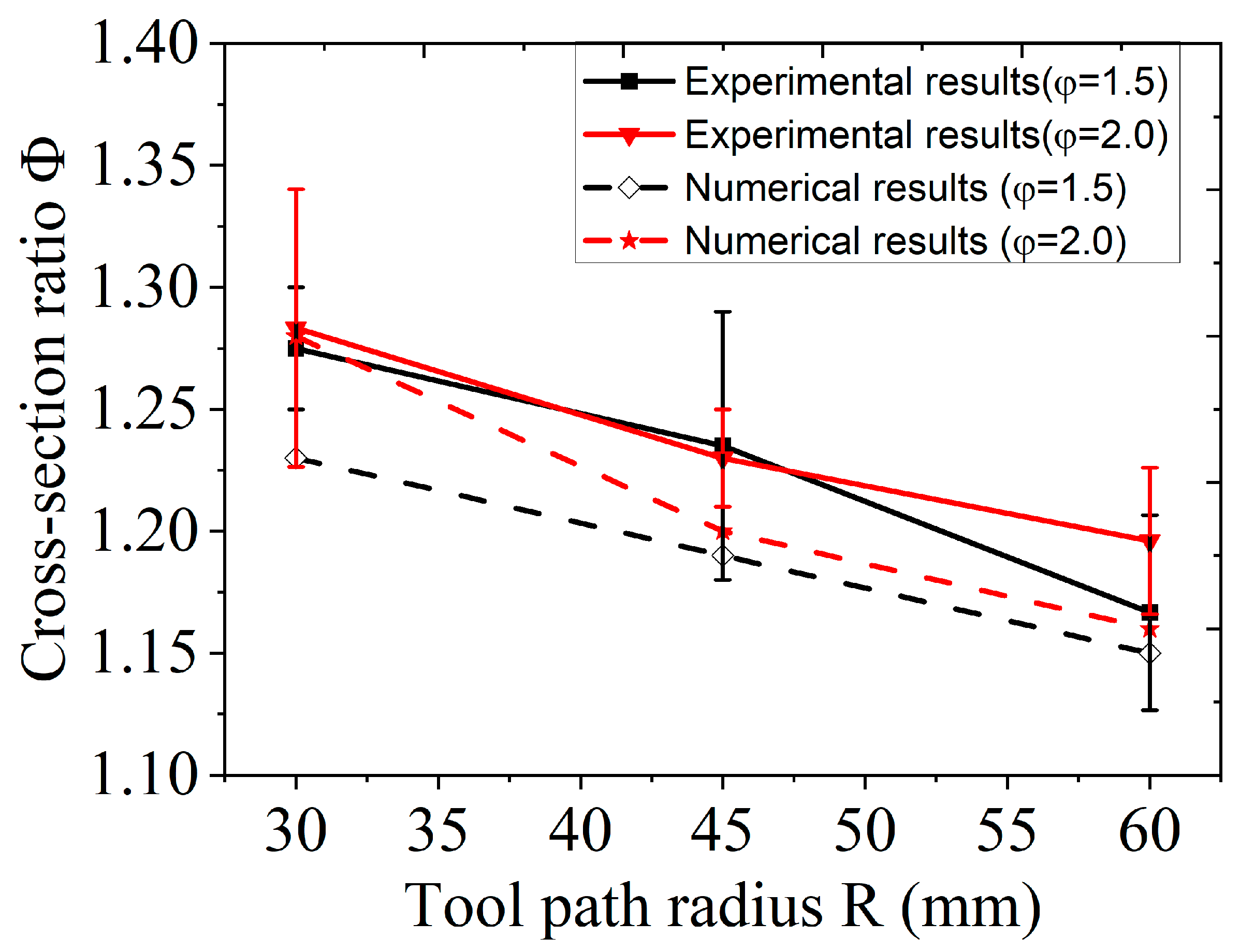
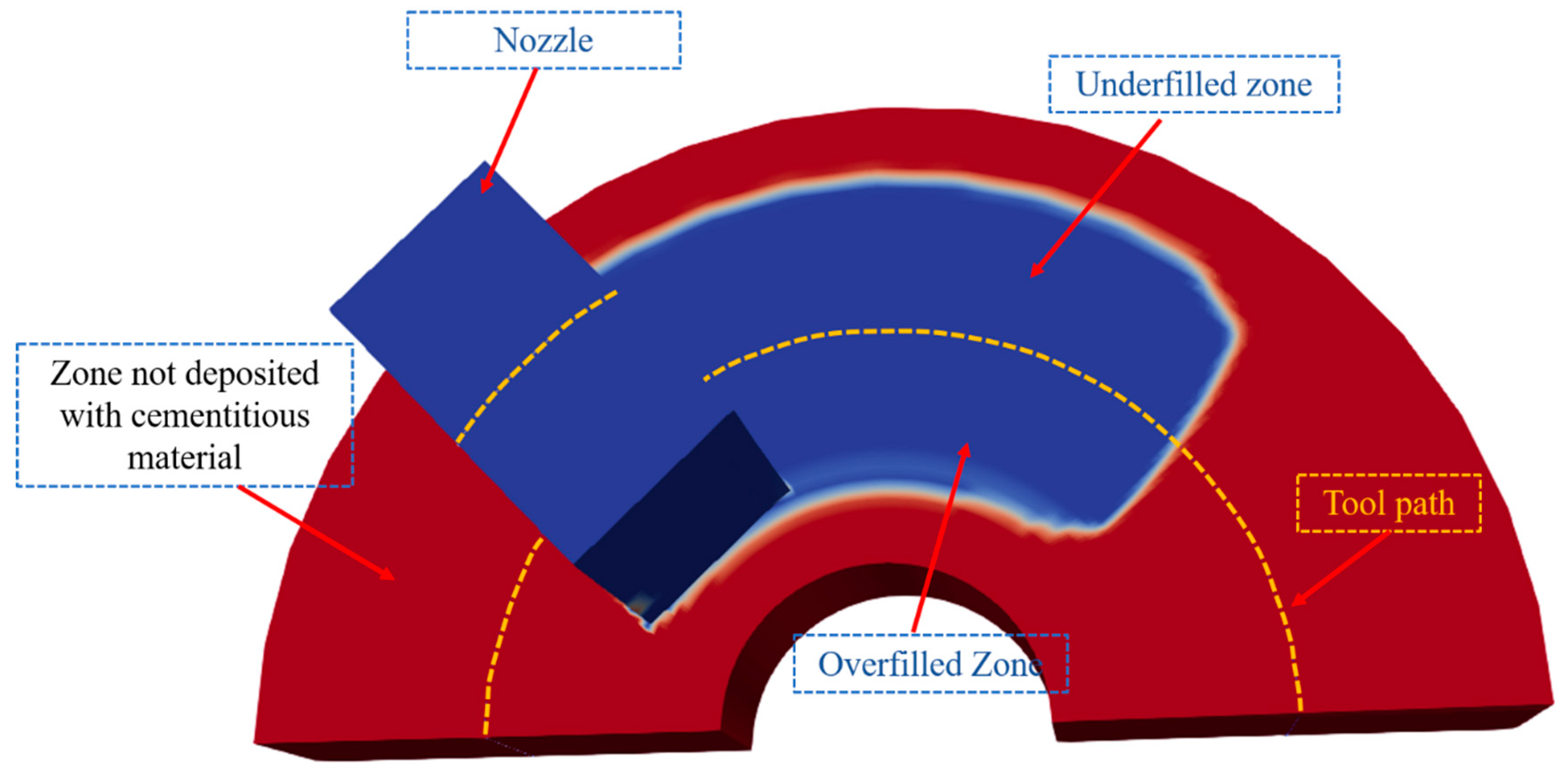
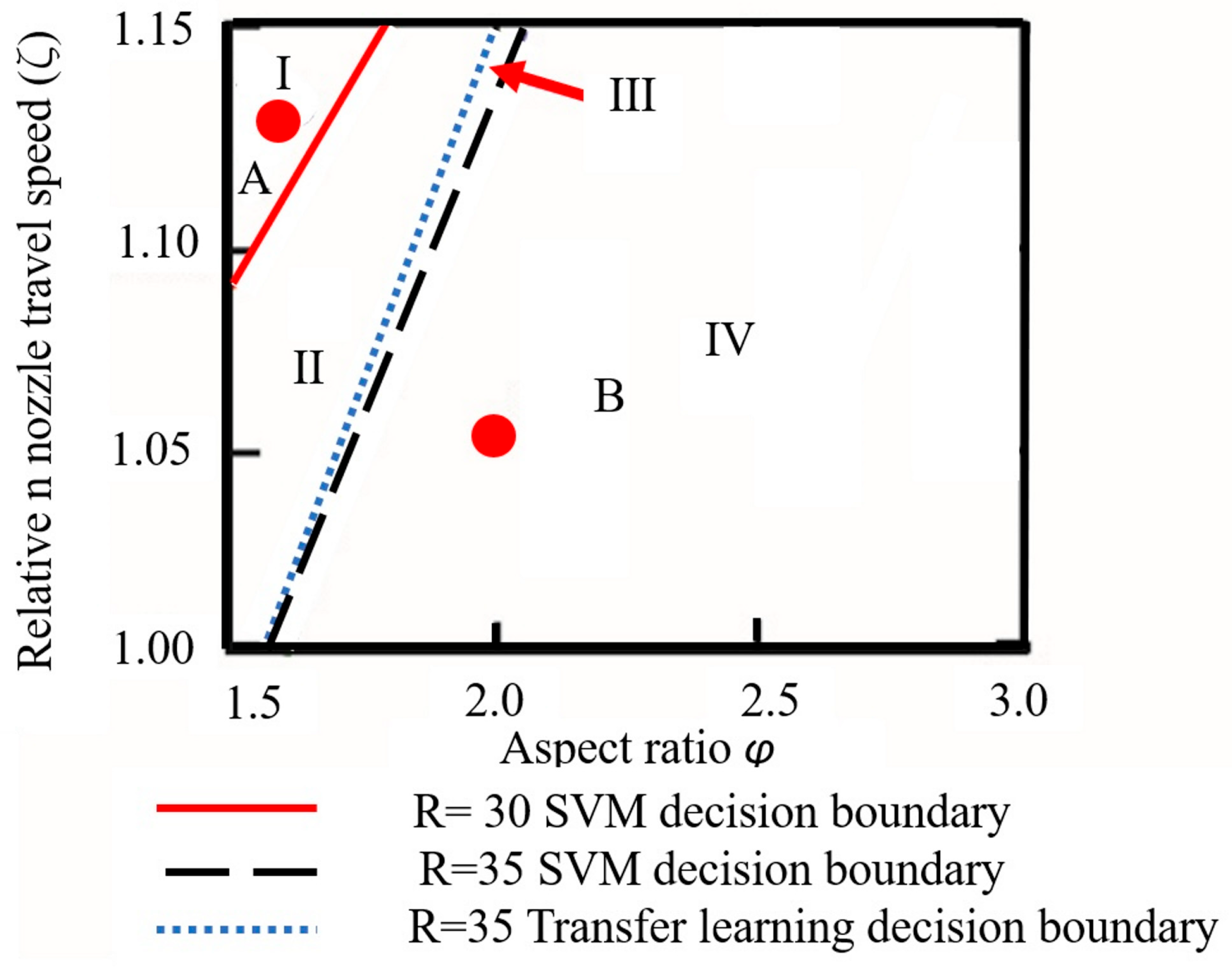
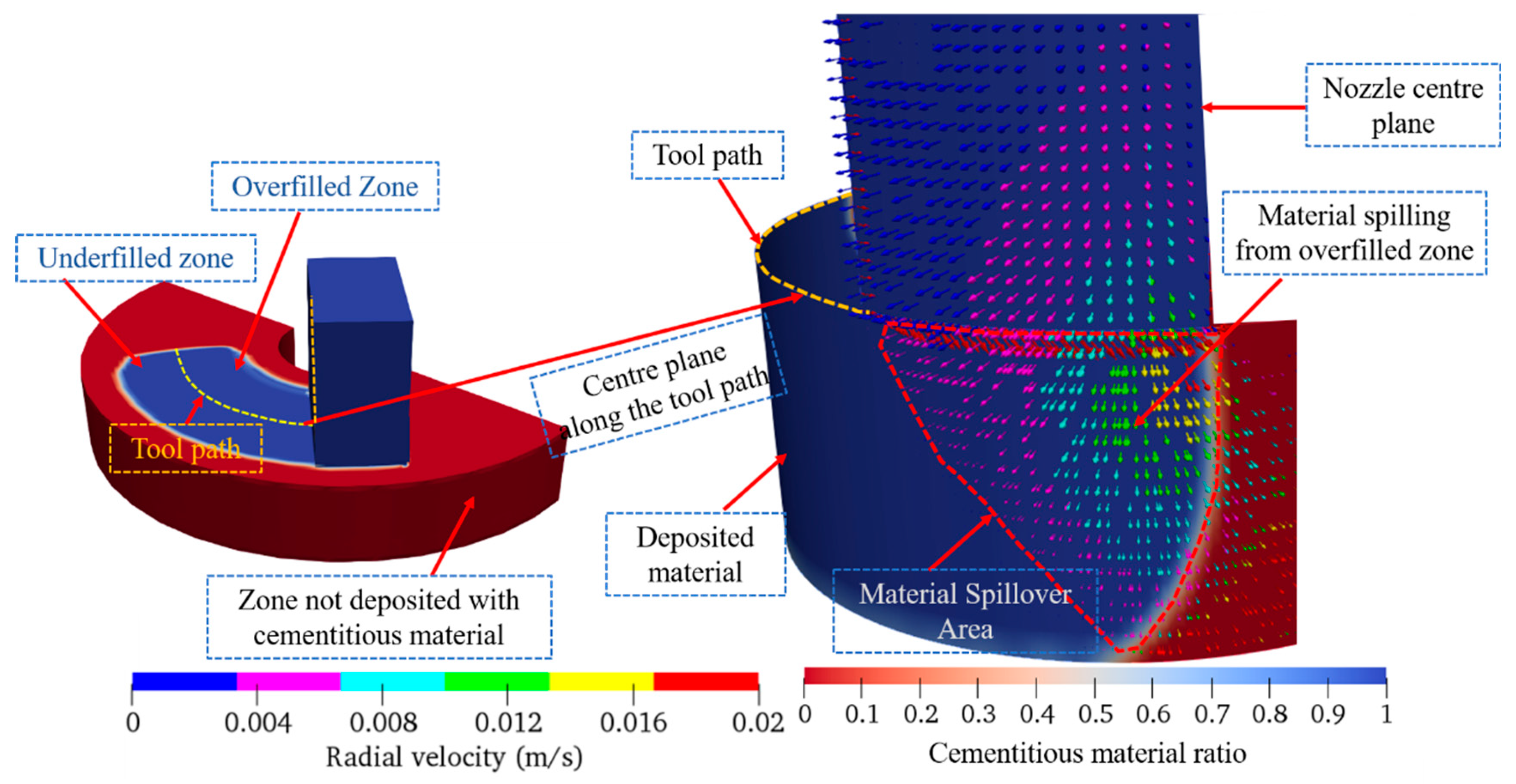
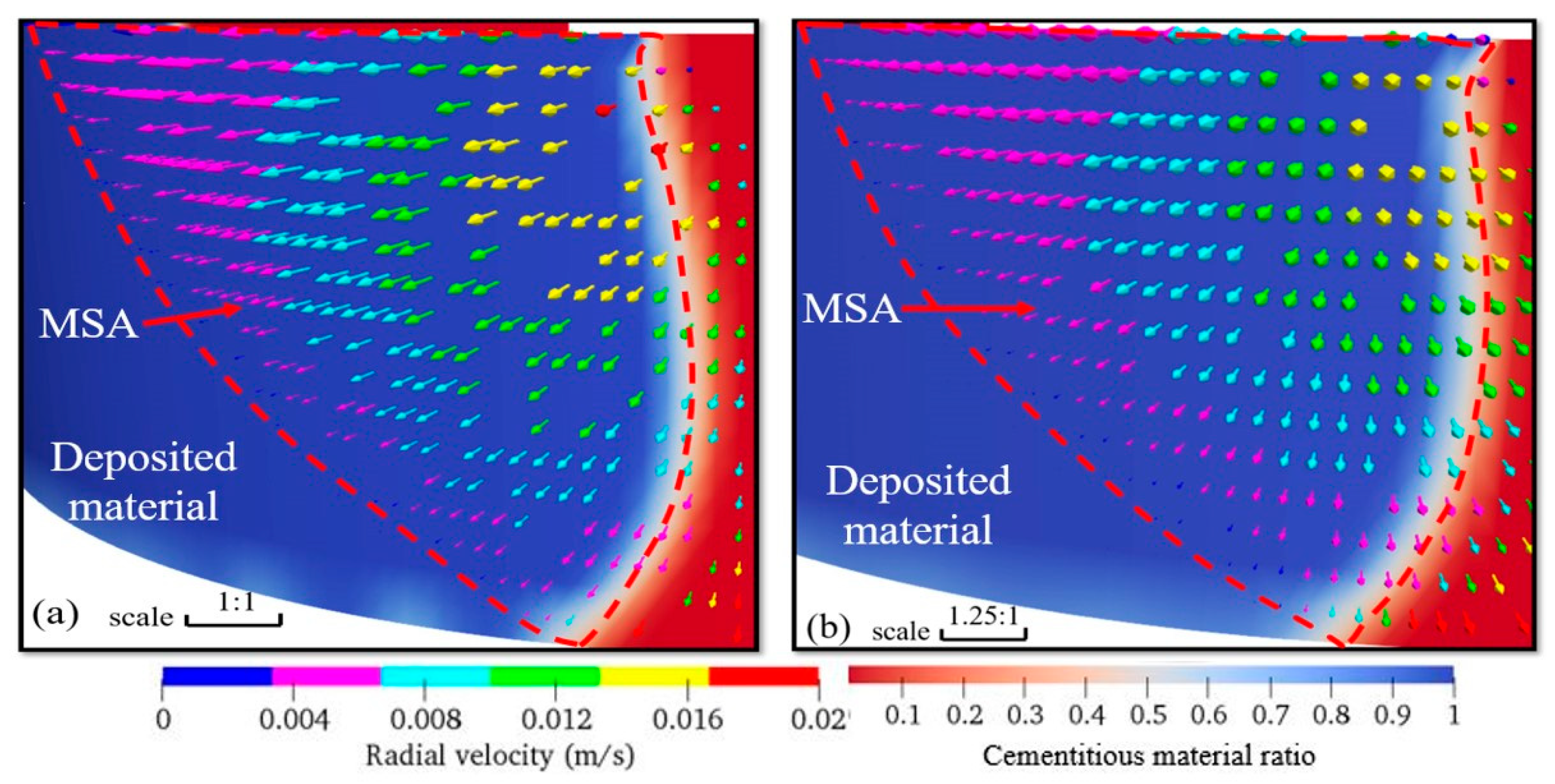
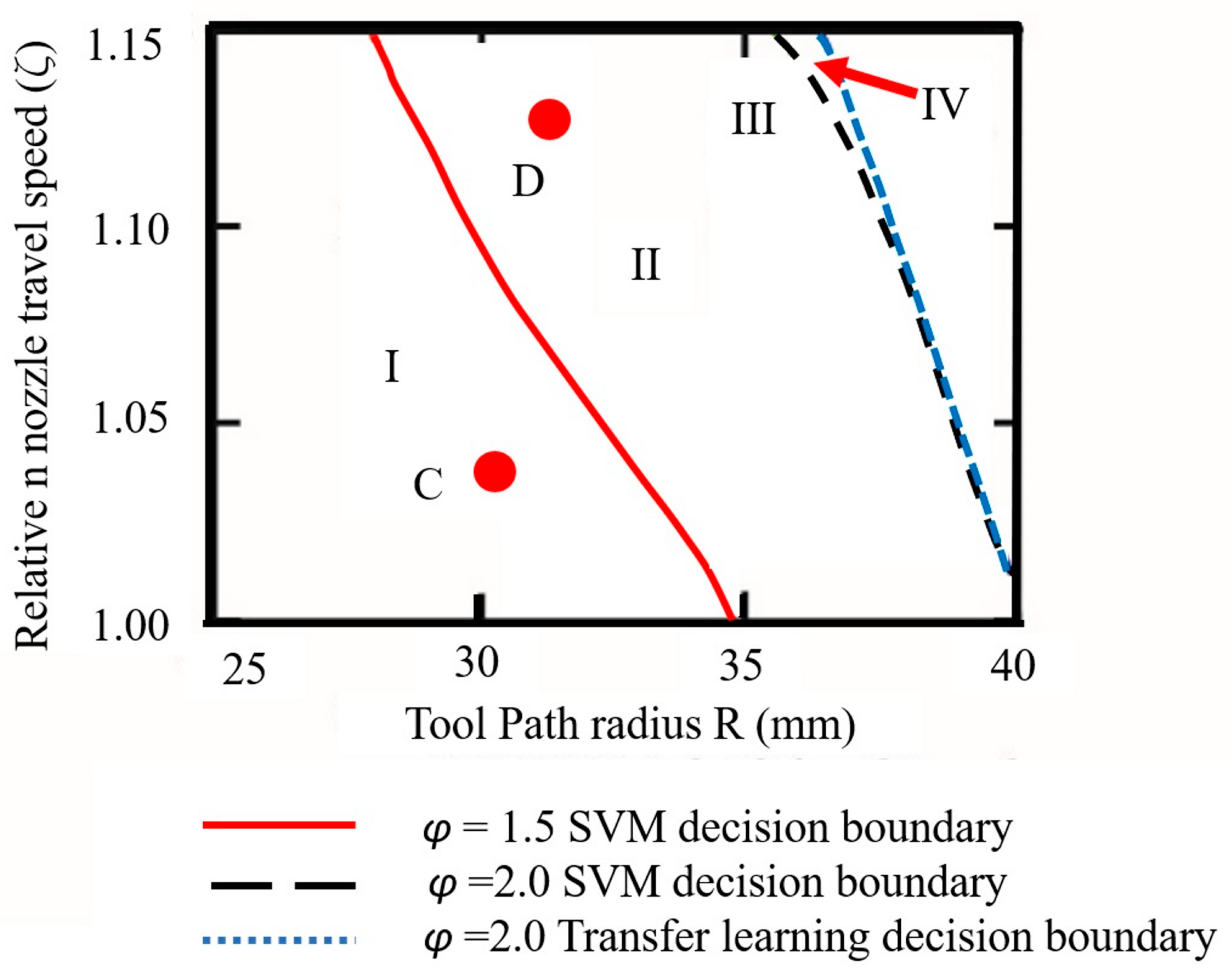
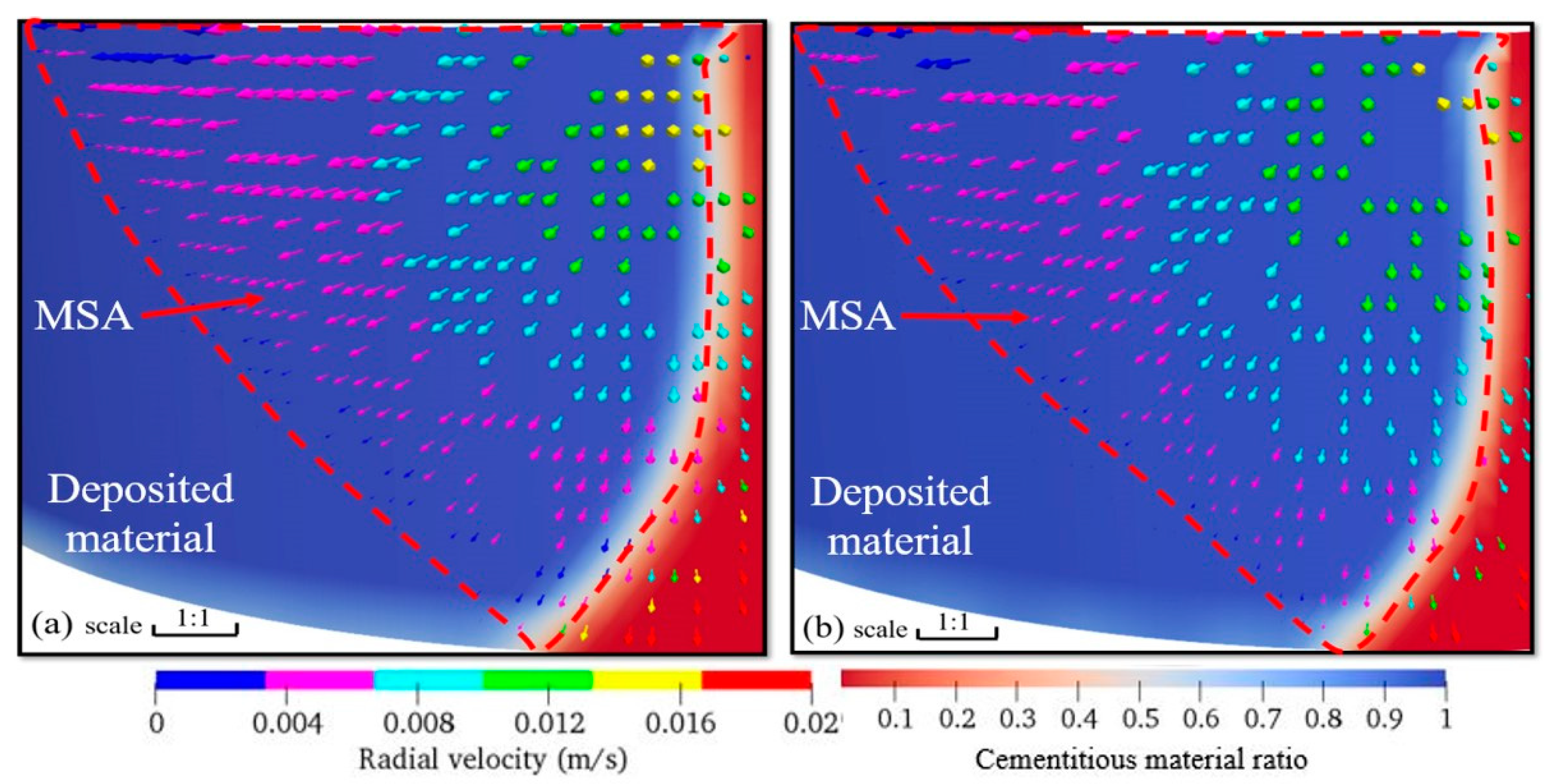
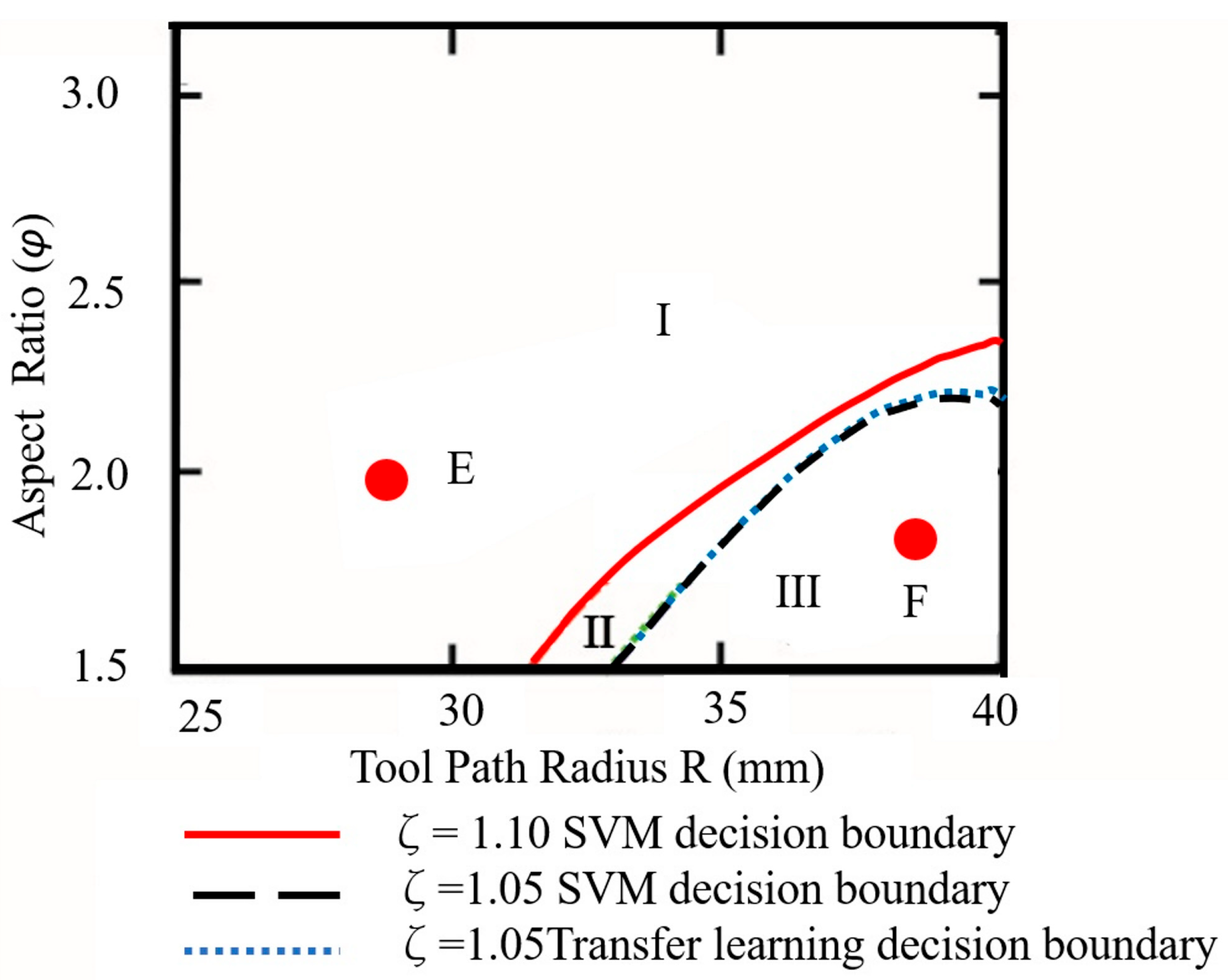
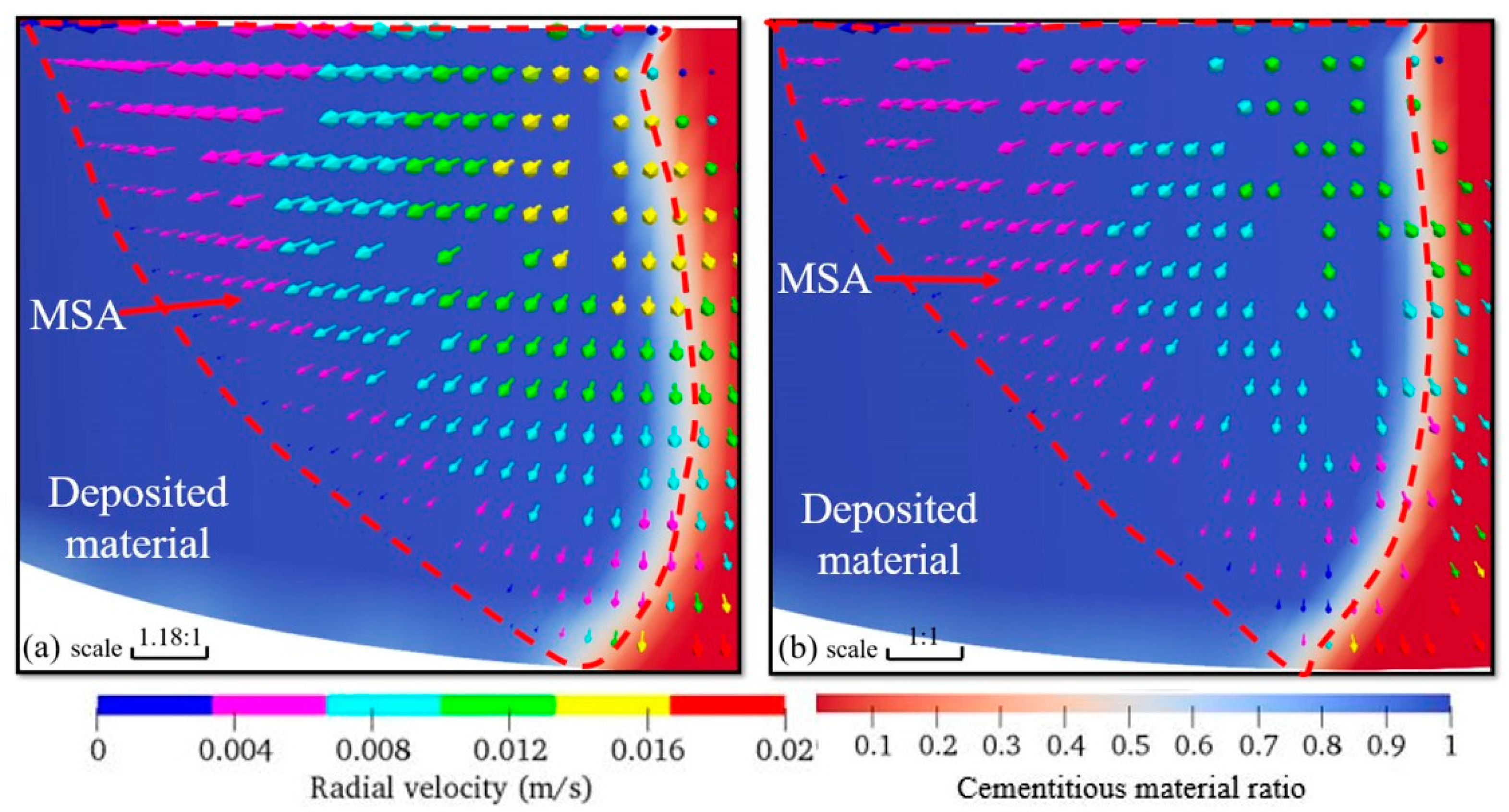
| No. | Mesh Number | Time Step | Iteration | Error Tolerance | Φ |
|---|---|---|---|---|---|
| 1 | 180,709 | 5.0 × 10−4 | 100 | 1.0 × 10−5 | 1.270 |
| 2 | 477,640 | 5.0 × 10−4 | 100 | 1.0 × 10−5 | 1.262 |
| 3 | 180,709 | 2.5 × 10−4 | 100 | 1.0 × 10−5 | 1.270 |
| 4 | 180,709 | 5.0 × 10−4 | 200 | 1.0 × 10−5 | 1.266 |
| 5 | 180,709 | 5.0× 10−4 | 100 | 5.0 × 10−6 | 1.271 |
| Conditions | Method | SDD | TDD | TD | Input | Output |
|---|---|---|---|---|---|---|
| R = 30 | SVM | Data as R = 30 | φ, ζ | Φ | ||
| R = 35 | SVM | Data as R = 35 | φ, ζ | Φ | ||
| Transfer learning | Data as R = 30 | Data as R = 35 | SDD + TDD | φ, ζ | Φ | |
| φ = 1.5 | SVM | Data as φ = 1.5 | R, ζ | Φ | ||
| φ = 2.0 | SVM | Data as φ = 2.0 | R, ζ | Φ | ||
| Transfer learning | Data as φ = 1.5 | Data as φ = 2.0 | SDD + TDD | R, ζ | Φ | |
| ζ = 1.10 | SVM | Data as ζ = 1.1 | R, φ | Φ | ||
| ζ = 1.05 | SVM | Data as ζ = 1.05 | R, φ | Φ | ||
| Transfer learning | Data as ζ = 1.1 | Data as ζ = 1.05 | SDD + TDD | R, φ | Φ |
| Conditions | Method | Data Sets | Error Rate | Process Window | Final Process Window |
|---|---|---|---|---|---|
| R = 30 mm | SVM | 200 | 0.17 | I | I in Figure 5 |
| R = 35 mm | SVM | 120 | 0.20 | I, II, III | I, II in Figure 5 |
| TL | 320 | 0.13 | I, II | ||
| φ = 1.5 | SVM | 200 | 0.10 | II, III, IV | II, III, IV in Figure 8 |
| φ = 2.0 | SVM | 120 | 0.17 | IV | III, IV in Figure 8 |
| TL | 320 | 0.07 | III, IV | ||
| ζ = 1.10 | SVM | 200 | 0.13 | II, III | II, III in Figure 10 |
| ζ = 1.05 | SVM | 120 | 0.13 | III | III in Figure 10 |
| TL | 320 | 0.13 | III |
| No. | Working Conditions | Predicted Φ | Experimental Results Φ |
|---|---|---|---|
| 1 | R = 30 mm, φ = 2.0, ζ = 1.05 | Φ > 1.20 | 1.25 ± 0.022 |
| 2 | R = 35 mm, φ = 2.0, ζ = 1.05 | Φ > 1.20 | 1.22 ± 0.038 |
| 3 | R = 35 mm, φ = 2.0, ζ = 1.10 | Φ > 1.20 | 1.23 ± 0.047 |
| 4 | R = 30 mm, φ = 1.5, ζ = 1.00 | Φ < 1.20 | 1.16 ± 0.040 |
Disclaimer/Publisher’s Note: The statements, opinions and data contained in all publications are solely those of the individual author(s) and contributor(s) and not of MDPI and/or the editor(s). MDPI and/or the editor(s) disclaim responsibility for any injury to people or property resulting from any ideas, methods, instructions or products referred to in the content. |
© 2025 by the authors. Licensee MDPI, Basel, Switzerland. This article is an open access article distributed under the terms and conditions of the Creative Commons Attribution (CC BY) license (https://creativecommons.org/licenses/by/4.0/).
Share and Cite
Liu, Z.; Si, L.; Liu, Y.; Li, M.; Wong, T.N. Optimization of Printing Parameters Based on Computational Fluid Dynamics (CFD) for Uniform Filament Mass Distribution at Corners in 3D Cementitious Material Printing. Crystals 2025, 15, 725. https://doi.org/10.3390/cryst15080725
Liu Z, Si L, Liu Y, Li M, Wong TN. Optimization of Printing Parameters Based on Computational Fluid Dynamics (CFD) for Uniform Filament Mass Distribution at Corners in 3D Cementitious Material Printing. Crystals. 2025; 15(8):725. https://doi.org/10.3390/cryst15080725
Chicago/Turabian StyleLiu, Zhixin, Liang Si, Yebao Liu, Mingyang Li, and Teck Neng Wong. 2025. "Optimization of Printing Parameters Based on Computational Fluid Dynamics (CFD) for Uniform Filament Mass Distribution at Corners in 3D Cementitious Material Printing" Crystals 15, no. 8: 725. https://doi.org/10.3390/cryst15080725
APA StyleLiu, Z., Si, L., Liu, Y., Li, M., & Wong, T. N. (2025). Optimization of Printing Parameters Based on Computational Fluid Dynamics (CFD) for Uniform Filament Mass Distribution at Corners in 3D Cementitious Material Printing. Crystals, 15(8), 725. https://doi.org/10.3390/cryst15080725






